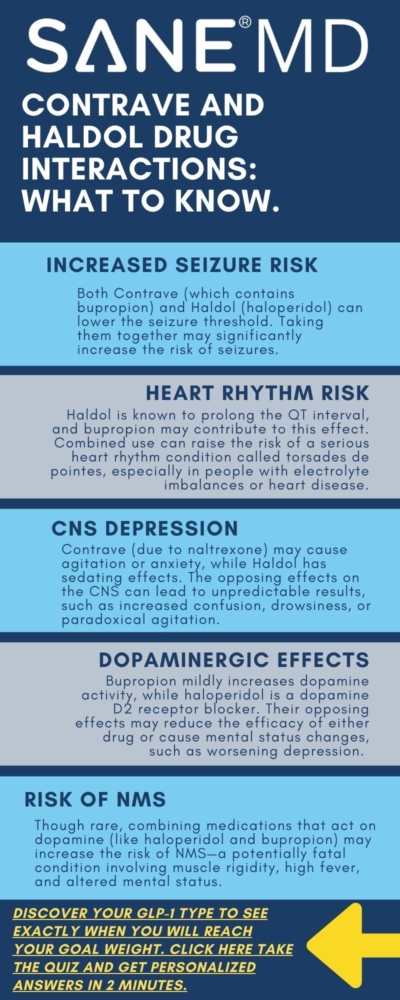Contrave and Haldol Drug Interactions: What You Should Know
Dr. Matthew Olesiak, MD, is the Chief Medical Director at SANESolution, a renowned wellness technology company dedicated to providing evidence-based solutions for optimal living. Dr. Olesiak earned his medical degree from the prestigious Jagiellonian University Medical College in Kraków, Poland, where he developed a strong foundation in medicine.

Combining medications can be life-changing—or life-threatening—depending on how the drugs interact in your body. This is especially true when using medications for weight loss or psychiatric conditions. One such combination, Contrave and Haldol, raises concerns about overlapping side effects, risks to mental stability, and the risk of seizures.
Understanding how these two medications affect one another is vital, particularly for patients managing both weight loss therapy and mental health disorders like bipolar disorder or major depressive disorder.
This article breaks down the potential Contrave and Haldol drug interactions, health concerns, and necessary precautions when taking Contrave and Haldol together.
Key Takeaways
- Taking Contrave with Haldol may increase the risk of serious side effects, including movement disorders, mental health changes, and a lowered seizure threshold.
- Patients with bipolar disorder, a seizure disorder, or other medical conditions must consult their doctor or pharmacist before combining these medications.
- Depending on your health history and treatment goals, the combination may require close monitoring, dosage adjustment, or even the use of other medications.
Understanding Contrave and Haldol
Contrave is a prescription medication specifically approved by the FDA for weight loss in certain adults who are overweight or obese and have a high initial body mass index (BMI ≥30, or ≥27 with comorbid conditions). The drug contains two active drugs: naltrexone hydrochloride, a drug class known as opioid antagonists, and bupropion hydrochloride, which belongs to a drug class of antidepressant drugs.
Bupropion hydrochloride is also found in other medications like Wellbutrin SR and Wellbutrin XL, used to treat depression and aid in smoking cessation. Meanwhile, naltrexone hydrochloride is known for its role in managing opioid withdrawal symptoms and alcohol dependence. Combined, these components help regulate brain pathways involved in appetite, cravings, and energy use. As part of a broader treatment plan that includes a reduced-calorie diet and increased exercise, Contrave treatment supports long-term weight loss and chronic weight management for compatible individuals.
However, taking Contrave requires careful oversight due to its potential to increase the risk of side effects, including high blood pressure, suicidal thoughts and behaviors, and a lowered seizure threshold. These risks can be magnified by certain drug interactions or underlying medical conditions, such as a history of seizure disorder, mental health instability, or liver impairment.
Haldol, or haloperidol, is a typical antipsychotic used for the treatment of psychiatric conditions, including schizophrenia, bipolar disorder, major depressive disorder with psychotic features, and acute psychosis. It alters chemical signals in the brain, primarily targeting the dopamine system, but it also affects the serotonergic neurotransmitter system. Haldol is often prescribed to manage severe agitation, delusions, hallucinations, and behavioral disturbances in psychiatric and medical patients.
While Haldol can be effective in stabilizing mental health, it is known for its potential to cause neurological side effects, including extrapyramidal symptoms (EPS), tardive dyskinesia, and, in rare cases, serotonin syndrome occurs when combined with other serotonergic agents. Because it is metabolized in the liver, it also poses concerns for those with severe hepatic impairment.
When used together, haloperidol bupropion interactions become clinically important. Taking Contrave alongside Haldol may lead to additive or synergistic effects on the seizure threshold, making it more likely that seizures will occur, especially in patients with risk factors such as a history of seizure disorder, mental health conditions, or who have suddenly stopped drinking alcohol.
Moreover, both drugs can affect blood pressure, the central nervous system, and emotional regulation, creating a scenario where side effects and adverse reactions must be closely monitored. The overlap in how these medications interact with the brain’s chemical messengers means that combining them can increase the risk of mental health changes, such as mood swings, irritability, or worsening depression.
Because of these risks, healthcare providers must consider the patient’s full health history, including other prescription drugs, over-the-counter drugs, and any ongoing medical conditions, before choosing to prescribe Contrave alongside Haldol.
Even though both medications are approved for their individual uses—one for weight loss and the other for mental health—their interaction represents a complex balance between benefit and harm. This is especially true when used in patients dealing with overlapping conditions such as bipolar disorder and obesity, or those struggling with opioid withdrawal and depressive symptoms.
For these reasons, the decision to start or continue taking Contrave while on Haldol should be made in consultation with a trusted doctor or pharmacist, ideally one who understands how the combination could affect the patient’s metabolism, drug effects, and risk of side effects.
Why Interactions Matter: Contrave’s Bupropion Component
The primary concern when combining Haldol with Contrave lies in the bupropion treatment. Bupropion is a known seizure threshold-lowering agent. Its presence in Wellbutrin SR, Wellbutrin XL, and Contrave extended-release tablets is associated with an increased risk of seizures—particularly in those with preexisting seizure disorder or who have suddenly stopped drinking alcohol.
“The combination of bupropion and haloperidol may amplify the risk of neurological side effects. Patients with any risk factors for seizures or psychiatric instability need to be evaluated very carefully,” says Dr. Matthew Olesiak, Chief Medical Director at SANE MD.
The boxed warning alerts doctors about the suicidal thoughts and behaviors associated with antidepressants, including bupropion hydrochloride. While it can support weight loss, smoking cessation, and mental health, these benefits come with an extensive list of possible side effects.
Potential Side Effects When Combining Contrave and Haldol
Combining Contrave and Haldol introduces a significant concern for overlapping and potentially amplified side effects, particularly those involving the nervous system, cardiovascular function, and mental health. The interaction between these two medications is not merely additive—it may produce unpredictable effects that require careful monitoring by a healthcare provider.
While each drug has its own profile of adverse reactions, using them together can increase the burden on the brain, liver, and cardiovascular system.
The most commonly reported side effects in patients combining these drugs include:
- Tremors: Involuntary shaking or trembling, especially in the hands or arms, may occur due to dopamine receptor interference from Haldol, which is further aggravated by bupropion’s effect on neurotransmitter levels.
- Restlessness or agitation: Known as akathisia, this inner sense of unease or inability to stay still is frequently associated with antipsychotics like Haldol and may be intensified by the stimulant-like properties of bupropion in Contrave treatment.
- Muscle stiffness: Also called rigidity, this symptom reflects abnormal muscle tone and is a hallmark of extrapyramidal symptoms (EPS). It can impair mobility and quality of life.
- Cognitive dulling or confusion: These symptoms result from disrupted neurotransmitter activity and may be worsened by increased systemic exposure to haloperidol when combined with bupropion.
- Suicidal thoughts and behaviors: Both bupropion hydrochloride and Haldol carry boxed warning risks for inducing or worsening suicidal thoughts and behaviors, especially in younger adults or those with untreated bipolar disorder.
- Dizziness or fainting: These may stem from blood pressure fluctuations, medication-induced sedation, or neurologic side effects—a risk heightened when taking Contrave with other CNS-active drugs.
- Low blood sugar: Though uncommon, low blood sugar can result from medication-related appetite suppression, altered eating patterns, or interactions with other drugs used for diabetes or metabolic disorders.
- High blood pressure: Both Contrave and Haldol have been independently associated with elevated blood pressure. When taken together, they can increase the risk of high blood pressure—a serious concern for individuals with cardiovascular risk factors or pre-existing hypertension.
Extrapyramidal Symptoms (EPS)
Both medications are capable of triggering extrapyramidal symptoms, which are drug-induced movement disorders.
These can present as:
- Involuntary facial grimacing
- Lip smacking or tongue movements
- Parkinsonian tremors
- Muscle rigidity
- Restlessness or pacing
While EPS is more commonly associated with antipsychotics like Haldol, taking Contrave—especially in patients sensitive to bupropion treatment—can compound the problem. This happens because bupropion hydrochloride affects dopamine levels, possibly interfering with haloperidol’s action in the brain’s basal ganglia, where movement is regulated.
Metabolic Concerns: Bupropion’s Impact on Haldol Levels
One lesser-known risk is that bupropion hydrochloride is a known inhibitor of the enzyme CYP2D6, which is involved in the metabolism of many prescription drugs, including Haldol. By inhibiting this enzyme, bupropion treatment can reduce the rate at which haloperidol is broken down, increasing its concentration in the bloodstream. This can result in increased risk of side effects, including sedation, movement disorders, and mental health changes like paranoia or emotional blunting.
This altered metabolism, referred to as increased systemic exposure, is especially important for older adults or those with impaired liver function, as it further complicates drug clearance and dosage adjustment decisions.
Psychiatric and Behavioral Side Effects
Behavioral and psychiatric side effects can also be severe. Some patients report:
- Worsening depression
- Irritability or aggression
- Anxiety or panic attacks
- Mania or hypomania (particularly in those with undiagnosed bipolar disorder)
- Emotional detachment or “flat affect”
The FDA boxed warning alerts doctors to the potential for suicidal thoughts and behaviors with any antidepressant drugs, including both bupropion and naltrexone combinations. Haldol also carries risks for mental health instability, especially when used at higher doses or in combination with other medications that act on the central nervous system.
Because of this, patients should be routinely screened for mental health deterioration during Contrave treatment, especially if they’re already taking Haldol or being evaluated for bipolar disorder, schizophrenia, or major depressive disorder.

Seizure Risk and the Lowered Seizure Threshold
Taking Contrave poses a well-documented risk of seizures, especially at higher doses or in patients with a seizure disorder. Haldol, while not a known seizure-inducer on its own, can also lower the seizure threshold in sensitive individuals.
This combination may be dangerous for:
- Those with epilepsy or a seizure disorder
- Patients with bipolar disorder
- People undergoing opioid withdrawal
- Individuals with severe hepatic impairment
- Those who have suddenly stopped drinking alcohol
“Even in people without a known history of epilepsy, combining medications that lower the seizure threshold is risky,” adds Dr. Olesiak. “Anyone starting Contrave treatment should disclose all medications, even over the counter drugs.”
If you have experienced a seizure before or have other risk factors—including head trauma or an eating disorder—this combination may significantly increase the risk of future events.
Blood Pressure Concerns
Blood pressure elevation is another shared side effect of both medications. According to a study published in the American Journal of Clinical Pharmacology, treatment with Contrave (naltrexone/bupropion) has been associated with modest increases in systolic blood pressure, particularly during the initial weeks of therapy or after dose adjustments. In contrast, Haldol (haloperidol) may cause orthostatic hypotension or, in some patients, elevated blood pressure, depending on individual response.
Healthcare providers must monitor blood pressure regularly in patients taking Contrave, especially if they are also prescribed Haldol or other medications that affect cardiovascular function.
Mental Health and Behavioral Concerns
Both Haldol and bupropion treatment can cause mental health changes—ranging from mood swings and suicidal thoughts and behaviors to hallucinations. These side effects are more likely in those with underlying bipolar disorder or major depressive disorder. In rare cases, serotonin syndrome occurs, particularly when other drugs affect the serotonergic neurotransmitter system.
Patients with these conditions must be closely monitored during treatment. The boxed warning for antidepressant drugs emphasizes that mood disorders may worsen or lead to suicidal thoughts and behaviors in vulnerable individuals.
If you or a loved one experiences sudden mood changes, hallucinations, or dangerous behavior patterns while taking Contrave, seek help immediately. Call your local emergency number or the suicide and crisis lifeline.
What Increases the Risk of Side Effects?
Certain risk factors amplify the likelihood of adverse outcomes when combining these drugs. These include:
- History of mental health conditions
- Concurrent use of systemic corticosteroids
- Use of prescription drugs that lower the seizure threshold
- Use of other weight loss drugs
- Lack of dose reduction or dosage adjustment
- Use of over-the-counter stimulants or herbal products like St. John’s Wort
Discuss any medical conditions, including past mental illness, seizures, or liver issues, with your doctor or pharmacist before starting Contrave.
Special Populations: Who Should Be Extra Cautious?
Older Adults
Seniors are more sensitive to side effects like confusion, dizziness, and low blood sugar. The combination of Contrave and Haldol should be considered carefully in this group.
Teens and Young Adults
There is a known increased risk of suicidal thoughts and behaviors in this age group when using antidepressant drugs such as bupropion hydrochloride.
People Undergoing Opioid Detox
Contrave contains drugs called opioid antagonists like naltrexone hydrochloride, which can worsen opioid withdrawal symptoms if taken too soon after the last opioid use. Combining Haldol may further complicate these adverse reactions.
How to Minimize Risk When Taking Contrave and Haldol
- Always disclose other medications and over-the-counter drugs.
- Avoid high-fat meals, which increase absorption and the risk of side effects during Contrave treatment.
- Consider a dose reduction if you’re experiencing strong side effects.
- Follow a structured, reduced-calorie diet to optimize weight loss without over-relying on medication.
- Schedule regular mental health and blood pressure check-ins with your provider.
When to Call for Help
Seek urgent care or dial your local emergency number if you experience:
- Seizures
- Chest pain or irregular heartbeat
- Hallucinations or delusional thoughts
- Difficulty breathing or a severe allergic reaction
- Intense suicidal thoughts
These may signal a medical emergency and require immediate attention.
Can You Still Use Both?
In some cases, healthcare professionals may choose to prescribe Contrave and Haldol together—especially when there are no better alternatives. This will depend on your health history, body weight, initial body mass index, and how well you’ve tolerated other drugs in the past.
However, this approach requires ongoing monitoring, frequent assessments, and full transparency with your doctor or pharmacist.
Frequently Asked Questions (FAQ)
When it comes to taking Contrave—especially alongside medications like Haldol—it’s natural to have questions about safety, effectiveness, and potential drug interactions.
Below are answers to some of the most common questions patients ask about Contrave treatment, bupropion hydrochloride, and managing side effects while achieving successful weight loss outcomes.
1. What medications should I avoid with Contrave?
Contrave drug interactions are prevalent with many different medications. Patients should avoid combining Contrave with any MAOI medications like Zyvox, drugs that lower the seizure threshold, such as other antidepressant drugs (Zoloft), antipsychotics, NSAIDs, stimulants (Ritalin), epilepsy medications like Tegretol, or over-the-counter cold medicines like Benadryl containing decongestants. Even Tylenol can interact negatively with Contrave.
Additionally, opioid medications like morphine and codeine, including opiate agonists, must be avoided due to the naltrexone hydrochloride component, which can trigger acute opioid withdrawal symptoms. Using other weight loss drugs like Qsymia at the same time may also increase the risk of dangerous side effects.
Always tell your doctor or pharmacist about every medication, supplement, or herbal product you’re taking before starting Contrave treatment.
2. Does bupropion interact with haloperidol?
Yes, bupropion hydrochloride, found in both Contrave and Wellbutrin SR, can interact with haloperidol (Haldol) in ways that affect drug metabolism and increase the potential for side effects. Bupropion inhibits the liver enzyme CYP2D6, which plays a role in breaking down Haldol. As a result, Haldol may build up in the bloodstream, leading to greater systemic exposure and increased risk of movement disorders, sedation, and behavioral changes.
These Contrave interactions are particularly concerning for individuals with mental health conditions or a history of seizure disorders.
3. Can you take Contrave if you have bipolar disorder?
Caution is strongly advised when prescribing Contrave to individuals with bipolar disorder, especially if the condition is not well-controlled. The bupropion hydrochloride component may trigger manic or hypomanic episodes, and the risk of mental health changes, including suicidal thoughts and behaviors, is elevated. Healthcare providers may consider dose reduction, frequent monitoring, or alternative therapies depending on the severity of the disorder and other medical conditions.
It’s essential to have an in-depth conversation with your doctor or pharmacist before starting Contrave treatment if you have any history of bipolar disorder or major depressive disorder.
4. How to maximize weight loss on Contrave?
To support effective weight loss while taking Contrave, it’s important to follow a structured plan that includes a reduced-calorie diet, regular physical activity, and close communication with your healthcare team. Avoiding high-fat meals is crucial, as they can increase the absorption of Contrave extended release tablets and heighten the risk of side effects.
Patients should also be consistent with their dosage schedule and avoid missing doses to maintain steady blood levels of the medication. Setting realistic goals and addressing emotional eating or underlying mental health concerns can further enhance success with Contrave treatment.
5. What medications should not be taken with Contrave?
Certain prescription drugs and over-the-counter drugs should not be combined with Contrave due to the potential for harmful Contrave interactions. These include other medications that increase seizure risk, such as tramadol, antipsychotics like Haldol, stimulants like Adderal or systemic corticosteroids. Patients taking opioids or drugs for opioid withdrawal must avoid Contrave, as naltrexone hydrochloride can lead to severe adverse reactions.
If you have a history of seizures, liver problems, or suddenly stopped drinking alcohol, you must notify your provider before taking Contrave, as these factors significantly increase the risk of dangerous outcomes.
6. Can you take Haldol with Wellbutrin?
Combining Haldol with Wellbutrin SR or Wellbutrin XL (both containing bupropion hydrochloride) is generally not recommended without close medical supervision. The combination may increase the risk of neurological side effects, such as tremors, stiffness, or extrapyramidal symptoms, and can further lower the seizure threshold. Bupropion’s interference with liver enzymes may also elevate Haldol levels, leading to adverse reactions like sedation or worsening mental health changes.
If both medications are necessary, your doctor may adjust the doses or monitor for complications, especially in patients with medical conditions like a seizure disorder or bipolar disorder.
Final Thoughts
The combination of Contrave and Haldol is not inherently unsafe but does come with significant risks, particularly relating to the seizure threshold, mental health, and blood pressure regulation. Patients should weigh the benefits of weight loss and symptom control against the increased risk of serious side effects.
If you’re considering this combination or are already taking Contrave, be honest with your healthcare provider about your current medications, medical conditions, and treatment goals.
References
American Journal of Clinical Pharmacology






